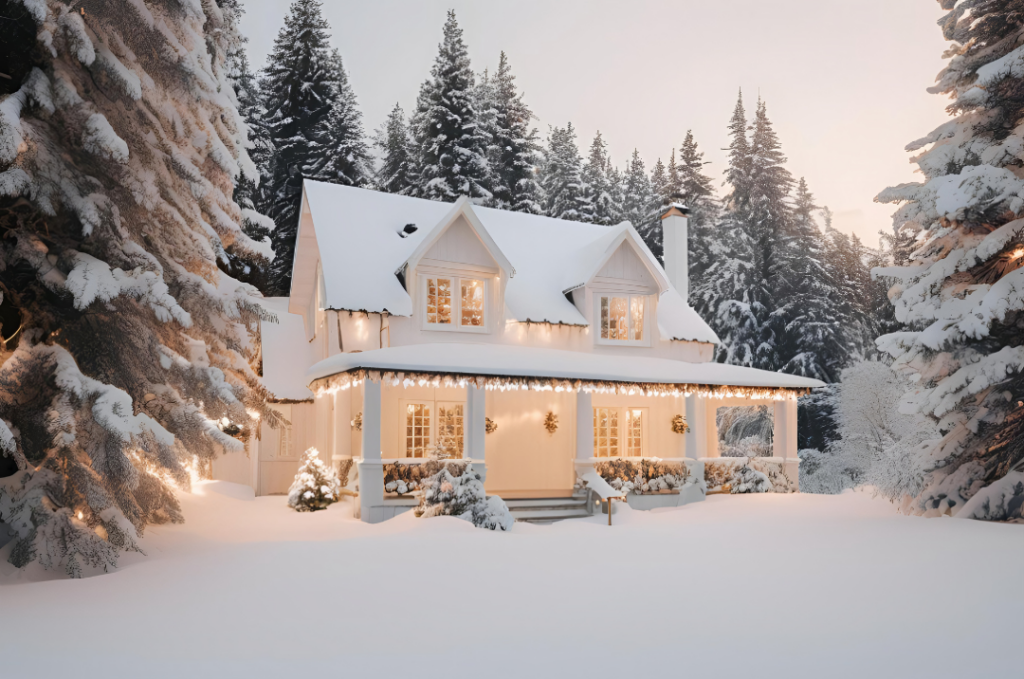Buying a home in New England during winter means more than just finding a property that fits your budget or style. The region’s harsh winters demand homes equipped with features that ensure warmth, safety, and efficiency. To make a wise investment, it’s essential to focus on aspects that will keep you comfortable during sub-zero temperatures, heavy snow, and icy conditions. Here’s a comprehensive guide to the top features you should prioritize when buying a winter-ready home in New England.

1. A Reliable Heating System
A dependable heating system is the cornerstone of any winter-ready home in New England. Without efficient heating, you could face discomfort and high energy bills during the region’s long, cold winters.
- Types of Heating: Look for systems like gas furnaces, heat pumps, or radiant floor heating. These are known for their efficiency and ability to keep homes warm even in freezing weather.
- Maintenance Records: Check for records of regular maintenance or recent upgrades.
- Zoning Features: Homes with zone-specific heating allow you to control temperatures in different areas, saving energy.
Pro Tip: Ask for past heating bills to gauge the system’s performance and efficiency during the coldest months.
2. Energy-Efficient Windows and Doors
Windows and doors are often culprits for heat loss. Energy-efficient upgrades can make a significant difference in keeping your home warm and lowering energy costs.
- Double or Triple Glazing: These prevent heat from escaping and reduce condensation on windows.
- Storm Windows and Doors: An extra layer of insulation helps combat cold drafts.
- Weatherstripping: Proper seals around windows and doors ensure that cold air stays out and warm air stays in.
Did You Know? According to the U.S. Department of Energy, heat loss through windows can account for up to 30% of a home’s energy use.
3. High-Quality Insulation
Insulation is your home’s best defense against freezing temperatures. Proper insulation ensures that your heating system works efficiently, saving you money and keeping you comfortable.
- Attic Insulation: Since heat rises, the attic is a critical area to inspect. Look for homes with sufficient insulation rated for New England’s climate.
- Wall Insulation: Older homes may lack modern insulation in their walls, which can lead to higher heating costs.
- Basement and Crawlspace Insulation: These areas often go overlooked but are essential to prevent cold floors and frozen pipes.
4. A Durable, Weather-Resistant Roof
Snow and ice can take a toll on your roof during winter. A strong, well-maintained roof is non-negotiable.
- Material: Metal roofs and architectural shingles are particularly effective in shedding snow and ice.
- Slope: A steep roof prevents snow buildup and minimizes the risk of ice dams, which can cause water damage.
- Ice and Water Shield: Check if the roof has an underlayment that provides additional protection against leaks caused by ice dams.
5. Backup Power Solutions
Winter storms in New England frequently lead to power outages. Having backup power solutions can be a lifesaver.
- Standby Generators: These automatically kick in during outages, keeping essential systems like heating and refrigeration operational.
- Battery Backups: Homes with solar panels often include battery storage as a sustainable power solution.
Pro Tip: Look for homes with already-installed backup generators or inquire about pre-wired systems for easy installation.
6. Properly Functioning Plumbing Systems
Frozen pipes are a common issue during New England winters, but the right plumbing setup can prevent costly repairs.
- Insulated Pipes: Pipes in crawlspaces, basements, or attics should be insulated to prevent freezing.
- Frost-Free Hose Bibs: Exterior faucets designed to resist freezing are a must-have.
- Water Heater Condition: A high-capacity, energy-efficient water heater ensures you won’t run out of hot water during peak usage.
7. A Mudroom or Entryway
New England winters mean snowy boots, wet coats, and plenty of gear. A mudroom makes life much easier.
- Storage Options: Built-in cubbies, hooks, and benches keep the space organized.
- Durable Flooring: Look for water-resistant options like tile or vinyl that can withstand snow and mud.
- Heating: A heated mudroom helps dry wet clothing and boots faster.
8. Garage and Driveway Features
Winter-ready homes should make navigating snow and ice easier.
- Heated Driveways: High-end homes may include snow-melting systems for hassle-free winters.
- Garage Access: An attached or heated garage protects your car from the elements and provides convenient access during storms.
- Paved Driveways: These are easier to clear of snow compared to gravel or dirt.
9. Outdoor Winter Safety Features
Snow and ice management is a major concern in New England. Look for homes with:
- Deicing Systems: Heated walkways or roofs that prevent ice buildup.
- Roof Rakes and Snow Removal Tools: Some sellers include these essentials with the home.
- Well-Maintained Gutters: Clear gutters reduce the risk of ice dams and water damage.
10. Proximity to Services
In winter, easy access to essential services can make a big difference.
- Plow Routes: Homes on main roads or plow routes are cleared of snow faster.
- Emergency Services: Proximity to hospitals, fire stations, and police ensures peace of mind during severe weather.
- Essential Stores: Being close to grocery stores and gas stations is convenient during storms.
11. Vacation Home Features
If you’re purchasing a vacation property in New England, consider features that enhance seasonal living:
- Proximity to Ski Resorts: Homes near popular destinations like Killington or Stowe attract renters and offer personal winter getaways.
- Rental Potential: Look for properties with high seasonal rental demand for extra income.
- Winterized Systems: Vacation homes should include winter-specific amenities like energy-efficient heating and remote monitoring systems.
Why a Winter-Ready Home Matters
A winter-ready home doesn’t just keep you warm—it also protects your investment by minimizing weather-related damage and operating efficiently during the coldest months. By focusing on these features, you’ll ensure your home is comfortable, safe, and prepared for New England’s toughest season.
Final Thoughts
Buying a home in New England during winter requires careful consideration of features that enhance comfort, efficiency, and safety. From a reliable heating system to insulated pipes and a strong roof, winter-ready homes are essential for thriving in the region’s harsh winters.
If you’re ready to find your perfect winter-ready home, I’m here to help. With expertise in the New England market, I’ll guide you to homes that meet your needs and exceed your expectations.
📅 Schedule a consultation: calendly.com/ericayang_cb
Let’s find a home that keeps you cozy and secure all winter long! ❄️🏡

